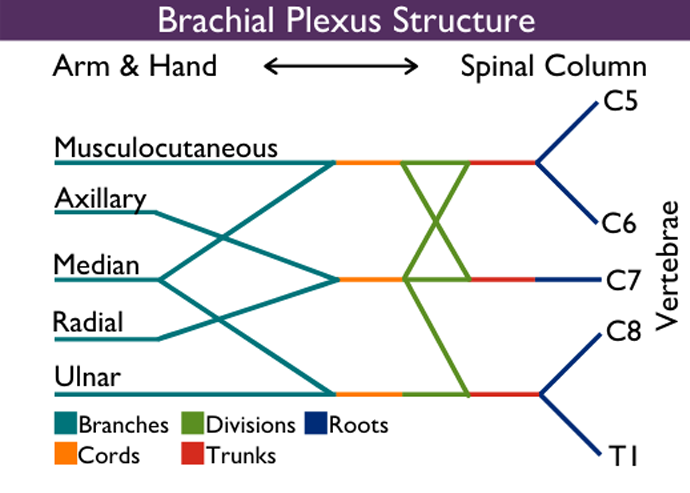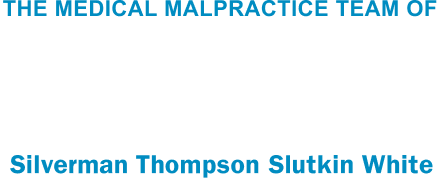Brachial Plexus / Erb’s Palsy
What is the Brachial Plexus?
The brachial plexus is a complex arrangement of nerve fibers running from the spine, and specifically, the lower four cervical nerve roots (C5, C6, C7, and C8) and first thoracic nerve roots (T1). This network provides motor and sensory innervation to the shoulder, arm, forearm, and hand. These nerves originate in the spinal cord in the neck and travel down the neck into the axilla (armpit region). The brachial plexus is divided into roots, trunks, divisions, cords, and branches. There are five roots (C5-8 & T1). These five roots merge to form three trunks (superior/upper: C5-6; middle: C7; and inferior/lower: C8-T1). Each trunk then splits into two, to form six divisions (the anterior division of the upper, middle and lower trunks; and posterior divisions of the upper, middle and lower trunks).
Learn more about the anatomy of the brachial plexus here.

Source: Brachial Plexus Injury | Johns Hopkins Medicine
Injuries to one or more of the nerve roots comprising the brachial plexus often occur as a result of excessive traction being placed on the head and neck of a newborn by the obstetrician during the delivery after the newborn’s shoulder has become stuck or impacted behind the mother’s pubic bone. This obstetric emergency is more commonly referred to as shoulder dystocia. If excessive force is applied to the newborn’s head/neck, the newborn can suffer stretching, compression, or tearing (avulsion) of the brachial plexus nerves; this may occur as a result of medical negligence. The term “avulsion” refers to the forcible tearing away or separation of the nerve root from the spine; i.e., the mechanism of injury is such that it involved enough stretching force to detach the nerve roots from the spine.
Nerve root injuries to the brachial plexus can be diagnosed through an x-ray of the neck and shoulder area to identify fractures to the bone or tissue, imaging tests such as an MRI or CT scan, and tests that use needle electrodes to determine nerve function and activity. The signs of a nerve root injury to the brachial plexus include loss of sensation in the arm, paralysis, sensory changes, atrophy of the muscles, and the noticeable positioning of the arm hanging down by the baby’s side. Typically, the baby’s arm cannot be raised from the side and the elbow is not flexible, preventing the victim from perform daily functions like typing and throwing. If the injuries to the nerves are limited to “stretching” type damage (mild damage), the injuries may be temporary in nature and resolve with dedicated physical therapy; more severe injury may require surgery to regain function.
What Is Erb’s Palsy?
If, however, the newborn suffers an avulsion (tearing) type injury to one or more of nerves comprising the brachial plexus, it is likely that the injuries will be permanent, although only your doctor can accurately assess the degree in which your child will be able to use the hand or arm functionally during their lifetime. Paralysis of the arm caused by injury to the arm’s main nerves (usually C5-6) is known as Erb’s palsy. The most common cause of Erb’s palsy is excessive lateral traction (stretching the head and neck in opposite directions) during birth, which is usually associated with shoulder dystocia. Some neurosurgeons will attempt to repair the nerve root avulsion by grafting a nerve from another location of the body into place on the torn-apart nerve.
It is recommended that newborns as young as three weeks old afflicted with Erb’s palsy receive daily to weekly physical and occupational therapy to help develop muscle strength. In addition, as these newborns grow older (with no improvement by six months), often they are forced to endure painful surgeries at the shoulder, elbow, wrist and finger to try improving function in those areas. Still, other children receive regular Botox injections to help improve shoulder and wrist function.
Despite these therapies, victims of shoulder dystocia/permanent Erb’s palsy often require a variety of accommodations, services and supports throughout their lifetime, the cost of which can be extremely high. Often, the cost of this lifetime of care can be financially ruinous for a family.
Contact a Medical Malpractice Attorney
For these reasons, we strongly recommend that you consult with our medical malpractice team to see if your child’s injuries were caused by a medical mistake for which your child may be entitled to a lifetime of compensation and care. Our lawyers routinely work with specialists such as doctors, life care planners, vocational rehabilitation counselors and economists to ensure that our clients are fairly and adequately compensated for all the injuries that they have experienced and will experience into the future.
If you or a loved one has been affected by Erb’s palsy, it is critical to have an informed, detail-oriented, and dedicated medical malpractice attorney who will tirelessly advocate for you and your case. Please contact Andrew G. Slutkin and Ethan S. Nochumowitz for a free consultation at 800-385-2243.






